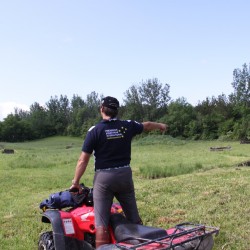EN reader Denya is back with multiple reports from recent clinics taught by Clayton Fredericks and Jessica Phoenix. Denya submitted one of our favorite clinic reports for 2012, and we’re excited that she’s back to share more from Canadian eventing. Her second report looks at a clinic Clayton Fredericks taught on June 1 and 2. Click here to read her first report. Take it away, Denya!
________
From Denya:
As I was discussing the clinic Clayton just gave at Arthur Tateishi’s Eventing Canada in Tottenham, Ontario, with my vet, who also events, she asked what was new compared to his clinic we both took six months ago in our area. I thought for a moment and realized that there were small nuggets of information that were new to us, but the core principles were the same. So why would you take the clinic a second time? Because those small nuggets are precious bits that continue to help us build a stronger base, a better ride, a more successful outcome. Why work with the same coach every day/week/month if only one or two lessons could accomplish everything? And besides, Clayton is engaging, witty, and has that great Aussie accent and phrasing. His clinics are fun, even while you work!
We went from polo shirts to parkas and back again, but, sporting as always, Clayton gave his positive energy to each session, with those core messages: get the horse between your legs and hands, and keep the shoulders, hips and heels in line. The “Pony Club kick” raised its head again more than once, twice … (keep counting. When you use your legs, the horse is to move forward without question. Don’t forget: “riding is NOT wrestling.” Other core messages are rein back as a demonstration of submission, canter poles for judging distance — “if you can’t see the distance to a canter pole, then you can’t jump, because accuracy is critical.” Balance and the “set up zone” is essential, so you can adjust your horse’s stride to meet a fence correctly. And — last but not least — have someone hold your horse, and find your “balance hold” position — knees up and level with the ground, and then out off the horse’s sides. There’s your “balance hold” position. Oh, those core muscles at work too!
My favourite new tip is at the end, but there are plenty others, so in no particular order:
We’ve all seen the eventers lose their reins to the buckle for various reasons — how to get them back? Hold the buckle, slide one hand down the reins, and when you have contact again, let go of the buckle and move that other hand up to the appropriate rein — voila — no reins flapping in the wind, no grabbing at air, and no uneven pressure on the bit for the horse. That’s how you stay straight even without reins. Have you all tried that? It works … but maybe try it in the ring first!
On the same page (sort of!), it’s important to school on different lengths of rein. This was eye-opening because you can’t always have the “correct” length of rein. If you’re competing, and lose your contact, especially in a combination, the horse should keep going. Practice letting the horse jump naturally, practice letting them balance themselves and not always depend on you. Clayton used a simple ditch to encourage the riders to jump on a loose rein, to let the horses use their heads and necks for balance, and jump in a natural shape.
Acceleration works to keep the horse straight without muscling them. Clayton was really pushing the riders to focus on one point on the top of a jump — a knot, a bump, a spot — and keep that spot until you and the horse are committed to the take-off spot and “when you land, GO!” Get going between fences, don’t lose time after the fence. And to see your distance 10 strides out — most didn’t know where 10 strides out started. When you can judge your distance 10 strides out, the change you need to make to compress or lengthen to meet the fence well is minimal, but from four strides out it’s abrupt, disruptive to the horse and seldom successful.
The footing was pretty heavy given all the rain. Another factor to consider: your horse needs more support, especially at take-off, so don’t overload their front end. Free up the front; keep the horse balanced so they don’t get strung out. In her clinic, Jessica Phoenix stressed a similar theme, especially working in bad weather.
This was funny in the telling, but actually translates really well. Hold your reins like you’re holding hands — not a grip; not a limp fish; but kindly, friendly, with compassion. A nice correlation.
My favourite bit? “Slow down time.” Clayton suggested that elite athletes (hey, I’m not quite that, but I still think I can use this) can slow down time to prepare, adjust, plan, to avoid rushing, which leads to costly mistakes. It was ably demonstrated by a rider who jumped a line, had to make a full U turn to another line, and made a hash of it. When the idea of slowing down time to imagine what should happen was introduced, the rider repeated the exercise with an excellent result.
So much to learn, so little time … if only we really could slow it all down. Take every opportunity to learn because there is always something new to take away. I just learned that for sure.
- Mix natural obstacles with painted poles.
- Loose rein — let the horse see the ditch.
- Double banks
- The “director” at work!
- A skinny in-and-out, mud, and lots of traffic.
- Look where you are going!
- Canadian coach Clayton Fredericks. Photo by Denya Massey.


























